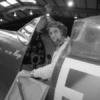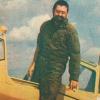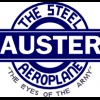

VoyTech
Members-
Posts
79 -
Joined
-
Last visited
Recent Profile Visitors
926 profile views
VoyTech's Achievements

New Member (2/9)
5
Reputation
-
All cowl tops on CBAF-built Mk IXs had a transverse panel line above the first (frontmost) exhaust section (so not halfway). The cowl tops on Supermarine-built Mk IXs (and VIIs and VIIIs, IIRC) show no such panel line. This has nothing to do with the Mk IX/XVI issue discussed here, because the absence of panel line on Supermarine-built aircraft can be observed from mid-1942 onwards and the presence of said panel line on CBAF-built aircraft from early 1943 onwards, long before the Packard-powered Mk IX concept which then became Mk XVI. However, I think (without a documentary proof, though) that this resulted from a slightly different curvature of the CBAF cowl tops, in which case one might argue that the CBAF cowl tops were more bulged than the Supermarine ones right from he beginning.
-
That's too tough for starters! "What's your favourite colour?"
- 27 replies
-
- 1
-

-
- 322 Sqn
- Spitfire Mk.Vb
-
(and 2 more)
Tagged with:
-
P/O Czachowski was indeed lost in P7835 ZF-S. P7833 PORTADOWN never served with any Polish unit. P7855 PK-K had the serial number applied in such a style that the 5s are often mistaken for 3s.
-

Spitfire external vs internal armoured glass
VoyTech replied to is it windy yet?'s topic in Aircraft WWII
AFAIK, Supermarine made the transition from early to late windscreen design in the W serial range, while CBAF introduced the late windscreen in EN/EP serial range. In both cases it was gradual, with both designs mixed in the batches. So, the safe rule is that every Supermarine-built Mk V with a serial startying with an A or B had the late windscreen, but every CBAF-built Mk V with a serial starting with an A or B had the early windscreen. All BM-serialled ones were built by the CBAF, so BM257 should have the early one. -
Just to confirm, I have a photo of TD118 JH-H. That's not the photo Graham mentioned, but another one that shows both the serial and code, and the high-back fuselage.
-
TD118 was also delivered to 6 MU on 1/3/45 and was a high back.
-
This is debatable! Photos of EN464, EN526 and EN527 in early to mid-1943 show all of them with narrow blister covers, so I guess EN520 had narrow blister covers from the outset as well.
-
I'm sorry to say (considering that I have some Scottish friends) that the only Polish saying (couldn't call it a proverb) that refers to the Scots that I know of is "as stingy as a Scotsman" ("stingy" meaning "preferring to spend as little money as possible, prefereably none"). And I know from my personal experience that it makes little (if any) sense, as the Scots I have met were usually quite willing to spend any amount of money that was needed, or more. As regards Scotish settlers in Poland, they were not limited to Cracow (Krakow) area. There has been a town called Nowe Szkoty (literally: New Scots) which is now part of the city of Gdańsk. Scottish nationals were mayors of the city of Lublin in 17th century.
-
I suppose you have to start by defining "Scottish ace". Do you mean: 1. an ace of Scottish descent 2. an ace born in Scotland 3. an ace who lived all/most of his life in Scotland 4. an ace who declared himself as a Scotsman or 5. any of the above? For example, Michal (Michael) Cwynar, born in Poland and an ace with the Polish Air Force in WW2, lived in Scotland for the next 60 odd years, until his death, and loved your country as much his native Poland.
-
The coolant header tank relief valve vent, located on the starboard engine cowling panel, and showing as a small circular opening (a black dot in most photos) was located in a different position on F.IX aircraft with Merlin 61s than on F.IXs with Merlin 63/63As or on LF.IXs. So it's not really a difference between F.IXs and LF.IXs, but rather between those Mk IXs with Merlin 61s and every other variation.
-
1. Totally agree that it's not important for the original questioner! 2. I daresay "StH" is at variance with what's on Aircraft Movement Cards in quite a few places. My data comes from: a. transcript of the Movement Card for P8701 done by a friend (so, admittedly, I can't guarantee it's any more correct than "StH"), b. 303 Sqn ORB, which was very detailed and generally credible at the time (quoting all sorts of flying, including fligh testing of new aircraft on arrival with the unit, not just ops). Is your database based on any other source than "StH" or its web-available transcripts? Possibly. The transfer of a number of Mk IIB's from 303 to 306 in July 1941 has not been recorded in their Movement Cards. As regards your impression, I think it might be based on widespread cliches and what's been published in books/magazines rather than on any actual documentary data. Having done some research into Spitfire allocations (about 1500 of them) to Polish units I'd say they weren't any less bothered about between-unit movement paperwork than RAF units in general. The 303/306 case of July 1941 is an exception rather than a rule.
-
While I can't comment on the metal ailerons on Mk IIBs, I don't think P8701 ever joined 303 Sqn. According to my data the Spitfire was delivered to Northolt on 14 (not 4) July, just missing 303 as the squadron left for rest. P8701 was allocated to 306 Sqn and used by them until mid-September 1941.
-
That's true for the wing tips, but the F.IX featured the fuel cooler intake in the port wing root, which the LF/HF.IX didn't have.
-
Well, "in numbers"... One is also a number! The last sentence should rather read "Some of the units that had the standard high backs also got a few bubble tops, too." As an example, of the units you mentioned, 308 Sqn got two low-backs by the end of the war. 302 Sqn also got two, nominally, but both were used by the wing HQ. I can't think of any 2TAF unit that converted entirely to low-back Mk XVIs.
-
I guess the paint type/quality as well as the care in aligning the bands was of little consequence if the painting was done on such a badly soiled aeroplane. Whatever paint it was it was likely to start peeling off as soon as it had dried out.




